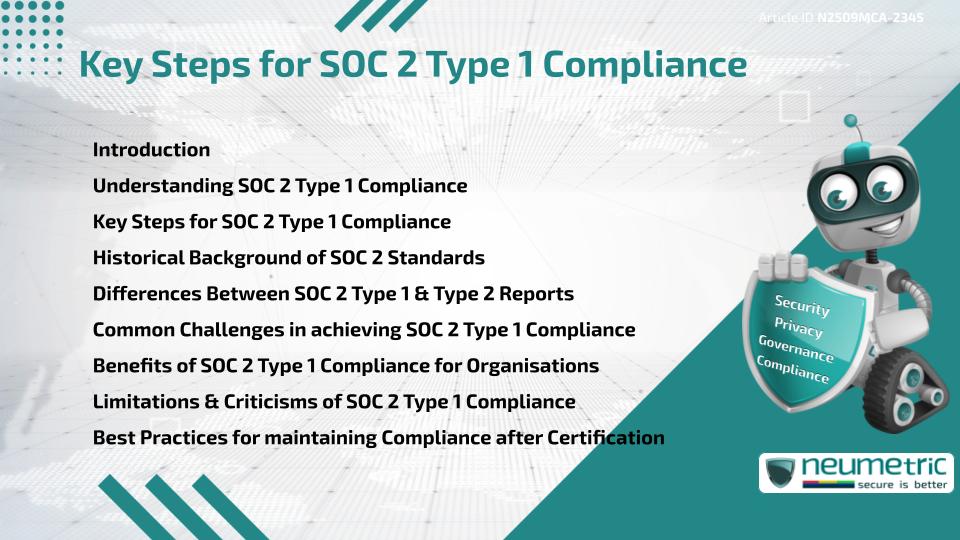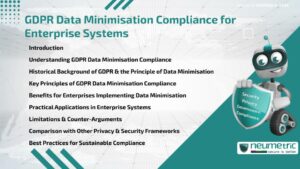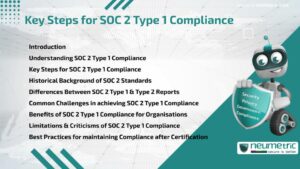Table of Contents
ToggleIntroduction
SOC 2 Type 1 Compliance is a widely recognised Standard that evaluates an organisation’s Controls related to Security, Availability, Processing Integrity, Confidentiality & Privacy. Developed by the American Institute of Certified Public Accountants [AICPA], it provides a snapshot of whether a company’s Internal Controls are suitably designed at a specific point in time. Achieving SOC 2 Type 1 Compliance is often a critical milestone for businesses that handle Sensitive Customer Data, as it demonstrates Trustworthiness & Adherence to industry Best Practices.
Understanding SOC 2 Type 1 Compliance
SOC 2 Type 1 Compliance assesses the design of a company’s Controls but not their ongoing effectiveness. This means the focus is on whether the organisation has Policies, Procedures & Systems in place to safeguard data. For example, if a company claims to restrict access to Sensitive databases, the Audit will verify that proper Access Control mechanisms are indeed configured. However, it does not test whether these Controls function consistently over time.
Key Steps for SOC 2 Type 1 Compliance
Achieving SOC 2 Type 1 Compliance typically involves several structured steps:
- Define scope & objectives: Identify which Trust Service Criteria [TSC]—such as Security or Confidentiality-are relevant to your Business Operations.
- Perform a Readiness Assessment: Conduct an Internal Review to identify Gaps between current Practices & SOC 2 Requirements.
- Develop & document Controls: Create formal Policies & Procedures that align with the chosen TSC.
- Implement security & operational Controls: Put necessary safeguards in place, including Access Controls, Monitoring Tools & Incident Response Plans.
- Engage an independent auditor: Hire a certified CPA Firm to evaluate your Controls against SOC 2 Type 1 standards.
These steps create a structured pathway for Organisations to meet Compliance Requirements.
Historical Background of SOC 2 Standards
The SOC 2 Framework was established by the AICPA to address growing concerns about Third Party Data Security. Unlike SOC 1, which focuses on Financial reporting, SOC 2 was designed for service Organisations that handle Customer Data. Over time, it has become one of the most widely adopted benchmarks for Technology Companies, Cloud Service Providers & SaaS platforms. SOC 2 Type 1 Compliance, in particular, serves as the entry point before pursuing SOC 2 Type 2 Certification.
Differences Between SOC 2 Type 1 & Type 2 Reports
One of the most common questions is how SOC 2 Type 1 differs from SOC 2 Type 2. The distinction lies in timing & scope. SOC 2 Type 1 Compliance evaluates the suitability of Controls at a single point in time, while SOC 2 Type 2 assesses their operating effectiveness over a defined period, typically six to twelve months. In other words, Type 1 answers “Are the right Controls in place today?” whereas Type 2 answers “Do those Controls consistently work over time?”
Common Challenges in achieving SOC 2 Type 1 Compliance
Organisations often face hurdles when preparing for SOC 2 Type 1 Compliance. Developing Documentation for existing practices can be time-consuming, especially if Policies have not been formalised. Smaller companies may struggle with resource allocation, as Compliance requires dedicated Personnel & Financial investment. Additionally, technical misalignments such as outdated Access Management tools can delay progress.
Benefits of SOC 2 Type 1 Compliance for Organisations
Despite challenges, SOC 2 Type 1 Compliance delivers valuable benefits. It enhances Customer Trust by demonstrating a commitment to Data Protection. Many enterprises require Vendors to have SOC 2 reports before entering into contracts, making Compliance a competitive advantage. Internally, the process helps Organisations identify weaknesses in their security posture & establish a stronger foundation for scaling operations.
Limitations & Criticisms of SOC 2 Type 1 Compliance
While useful, SOC 2 Type 1 Compliance is not without criticism. Some argue that it provides only a “snapshot in time” rather than a continuous assurance of security practices. Because it does not assess how Controls perform over an extended period, it may give Organisations a limited view of their actual resilience. This limitation underscores why many businesses pursue SOC 2 Type 2 after achieving Type 1.
Best Practices for maintaining Compliance after Certification
Obtaining SOC 2 Type 1 Compliance should not be seen as the end of the journey. Organisations should conduct periodic Reviews of their Controls, update Policies to reflect operational changes & provide ongoing Employee Training. Implementing automated Monitoring Tools can also help maintain Compliance readiness. Treating Compliance as an evolving process ensures that the organisation remains aligned with both Regulatory expectations & Customer Trust.
Takeaways
- SOC 2 Type 1 Compliance verifies the design of Controls at a specific point in time.
- Preparation involves Defining Scope, readiness Assessments, Documentation, Implementation & Audit.
- It differs from SOC 2 Type 2 by focusing on design suitability rather than operational effectiveness.
- Challenges include Resource Allocation, technical Gaps & extensive Documentation needs.
- Compliance improves Trust, Credibility & Readiness for future Audits.
FAQ
What is SOC 2 Type 1 Compliance?
It is an Audit that evaluates whether an organisation’s Data Protection Controls are suitably designed at a given point in time.
How is SOC 2 Type 1 different from SOC 2 Type 2?
Type 1 assesses design suitability at a single point in time, while Type 2 evaluates the operating effectiveness of those Controls over a longer period.
Who needs SOC 2 Type 1 Compliance?
Technology companies, SaaS Providers, Cloud service firms & any organisation handling Customer Data often require SOC 2 Type 1 Compliance.
How long does it take to achieve SOC 2 Type 1 Compliance?
The timeline varies depending on organisational readiness but typically ranges from two (2) to six (6) months.
What are the benefits of SOC 2 Type 1 Compliance?
It enhances Customer Trust, provides a competitive advantage & helps Organisations strengthen internal Security Practices.
Is SOC 2 Type 1 enough for long-term assurance?
Not entirely. While it establishes a strong foundation, Organisations often pursue SOC 2 Type 2 for ongoing validation of Control effectiveness.
What are common challenges in SOC 2 Type 1 Compliance?
Challenges include resource allocation, creating detailed documentation & addressing Technical or Operational Gaps.
Need help for Security, Privacy, Governance & VAPT?
Neumetric provides organisations the necessary help to achieve their Cybersecurity, Compliance, Governance, Privacy, Certifications & Pentesting needs.
Organisations & Businesses, specifically those which provide SaaS & AI Solutions in the Fintech, BFSI & other regulated sectors, usually need a Cybersecurity Partner for meeting & maintaining the ongoing Security & Privacy needs & requirements of their Enterprise Clients & Privacy conscious Customers.
SOC 2, ISO 27001, ISO 42001, NIST, HIPAA, HECVAT, EU GDPR are some of the Frameworks that are served by Fusion – a SaaS, multimodular, multitenant, centralised, automated, Cybersecurity & Compliance Management system.
Neumetric also provides Expert Services for technical security which covers VAPT for Web Applications, APIs, iOS & Android Mobile Apps, Security Testing for AWS & other Cloud Environments & Cloud Infrastructure & other similar scopes.
Reach out to us by Email or filling out the Contact Form…





